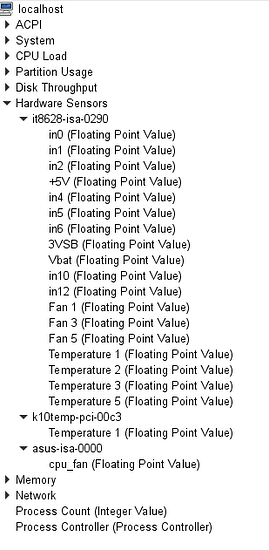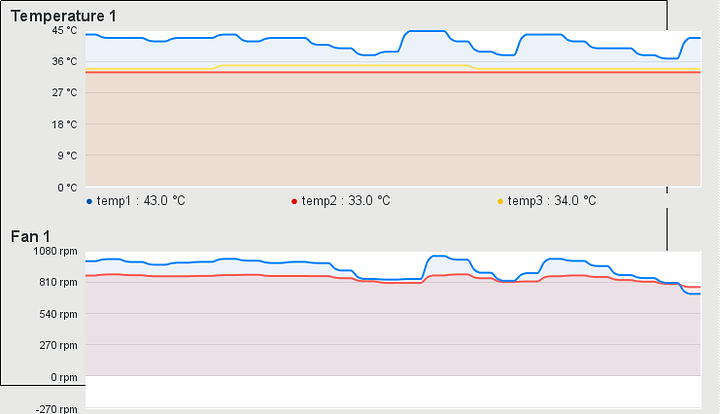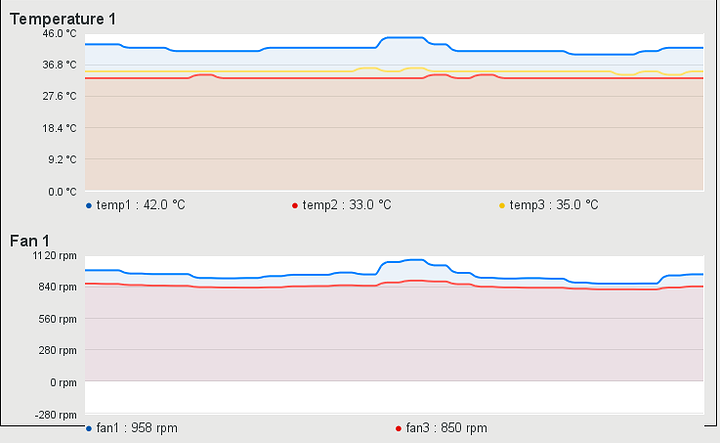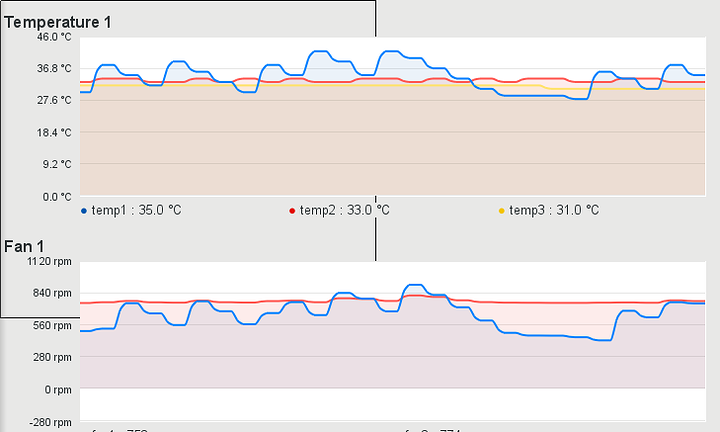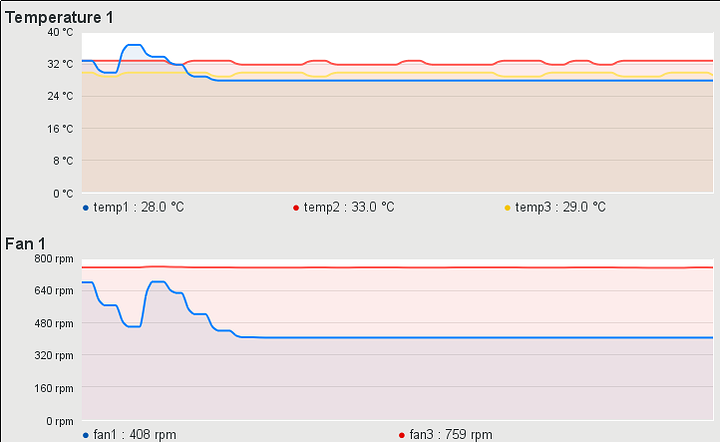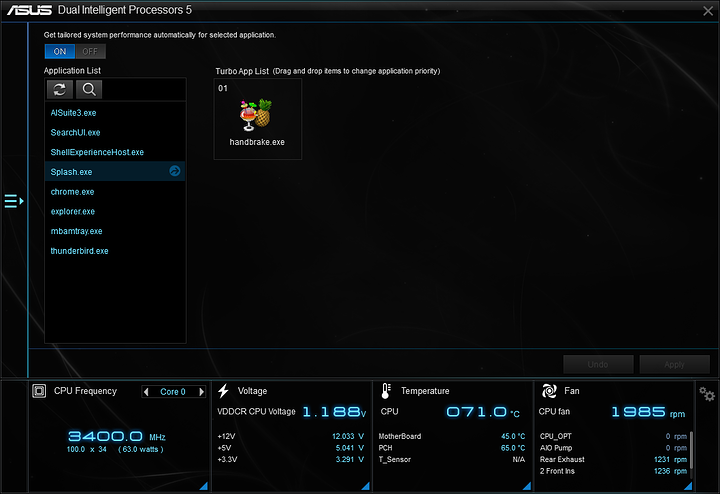@dominiquew What did you use to obtain those temperature graphs?
Hello Sceps,
I am running Linux OpenSuse Leap 42.3 with XFce windows manager and up-to-date “Kernel:Stable”
The pictures are snapshots of Ksysguard ( linux monitoring tool interface ), that I took with Gimp.
The “Sensors” and “monitoring-plugins-sensors” packages needs to be installed and configured for the it8628 chipset, it is not too complicated to do, althought not all the measuring points work 
here the list of point provided
temp1 is the CPU,
KR
Domi
@Steinwerks thanks for the update notice, yet another one
As for the SMU update I would assume this would include the security modules firmware fixes for the issues raised in a spectacular maner by CTS and claimed “unfixable”
AMD released the fixes 3 weeks ago for the integrators
https://www.amd.com/en/corporate/security-updates
=> secure processor, PSP escalation etc…
just read an update from phoronix, seems that the AGESA update benefits the Ryzen + 2700x performance, on Linux, nothing about our good “old 1700x” though 
A pitty that Asus do not communicate better the release notes, keeps us guessing
KR
Ok, did install the 4011
No worry, no regression.
Again almost thought that 3000MHz could be stable, but quickly gave up at first quirk, so I am back my prevous settings and to a stable 2933MHz
as for the power management I will need a few days to have a better view as the ambient temp is now 2°c up, still a nice idle low temp in the 28°C but for the moment it seems to drop a little bit slower
KR
Domi
How do you define stable / not stable?
Nice temps.
I know I wasn’t asked but this would be my answer.
If I can make the thing crash or hit limits just by running some programs, it’s not good enough. I am running mprime -t (prime95 kind of), memtest, a blender build from git using pacman (that was just to check for “segmentation fault” error), unigine valley… stuff like that to stress components. Is that realistic? No, mostly not. But that is the point. If the system can handle those unrealistic workloads, anything else will be running fine, even over long periods of time.
As a side note: I am currently running 4x8GB Kingston 2400MHz ECC DDR4 (micron stuff I think) without any problems on the prime and ECC seems to be working just fine. I am on BIOS 3805 on that one, I will update it shortly.
What do you mean by “hit limits”?
How long do you run mprime? Do you aim for no errors on it running indefinitely?
I just finished an ITX build and I tried to make a R9 nano work in that but it just gets too hot. Even modding the cooling didn’t help. So, a thermal limit would be an example.
Well, indefinitely is … a bit long. When I build a system generally I just let the first couple tests pass. Later with an installed OS I let it run at least until temps stop climbing, most times that means simply over night.
indeed for the temp I am impressed too by the noctua, I hesitated for the bigger one but this one already bearly left just enough room for the RAM installation 
As for stability, as stated earlier in this thread I realized during my initial testing, that ryzen POST test were very sensitive, so instead of booting once and passing as much tests as possible to assess stability… I rather boot 5 to 10 times (soft and hard) BEFORE I do any other test.
This time it did not pass 5 consecutive boot cycles without a problem with the SPD overclock memory setting at 3000Mhz (even with cas at 16 instead of 15) hence the not-rock-stable status
Honnestly this methodology saves me quite some testing time and once passed it I never ( again on this platform) left me experiencing any instability in normal usage.
KR
Domi
@dominiquew If rebooting is as sensitive as stress testing, might as well save time that way. Clever.
Still impressed by ~30C temp at 20C ambient, or +10C, on an overclocked 1700X with an air cooler. How fast are your cpu/case fans spinning?
My fan settings are more agressive than the original because thermic headroom is essential to ryzen overclocking:
CPU Q-Fan Control [PWM Mode]
CPU Fan Smoothing Up/Down Time [0 sec]
CPU Fan Speed Lower Limit [200 RPM]
CPU Fan Profile [Manual]
CPU Upper Temperature [58]
CPU Fan Max. Duty Cycle (%) [100]
CPU Middle Temperature [25]
CPU Fan Middle. Duty Cycle (%) [20]
CPU Lower Temperature [20]
CPU Fan Min. Duty Cycle (%) [20]
AIO_PUMP/W_PUMP+ Control [Disabled]
Chassis Fan 1 Q-Fan Control [DC Mode]
Chassis Fan 1 Q-Fan Source [CPU]
Chassis Fan 1 Smoothing Up/Down Time [0 sec]
Chassis Fan 1 Speed Low Limit [600 RPM]
Chassis Fan 1 Profile [Manual]
Chassis Fan 1 Upper Temperature [58]
Chassis Fan 1 Max. Duty Cycle (%) [100]
Chassis Fan 1 Middle Temperature [33]
Chassis Fan 1 Middle. Duty Cycle (%) [60]
Chassis Fan 1 Lower Temperature [27]
Chassis Fan 1 Min. Duty Cycle (%) [60]
Allow Fan Stop [Disabled]
Chassis Fan 2 Q-Fan Control [DC Mode]
Chassis Fan 2 Q-Fan Source [CPU]
Chassis Fan 2 Smoothing Up/Down Time [0 sec]
Chassis Fan 2 Speed Low Limit [600 RPM]
Chassis Fan 2 Profile [Manual]
Chassis Fan 2 Upper Temperature [55]
Chassis Fan 2 Max. Duty Cycle (%) [100]
Chassis Fan 2 Middle Temperature [36]
Chassis Fan 2 Middle. Duty Cycle (%) [60]
Chassis Fan 2 Lower Temperature [24]
Chassis Fan 2 Min. Duty Cycle (%) [60]
Allow Fan Stop [Disabled]
I have put fans and (CPU) temp on the same tab in Ksysguard for the graphs
with busy system ( 2 windows VM checking for windows update)
and now running the update
at low activity, the CPU fan will go as low as 350rpm with variations following the CPU temp up to 800rpm, the non-pwm chassis fan do not go under 770 RPM
Actually the fan speed variations are a bit audible, but the noise level is still quite acceptable
I will add the idle graph when the updates are finished 
there we go, just finished, shut down the VM and the system is nicely settling down
and completelly idle
KR
Domi
Well it’s been a while, but after getting some hard locks and memory errors on 4011 I checked the ASUS page and behold! A new BIOS version!
http://dlcdnet.asus.com/pub/ASUS/mb/SocketAM4/PRIME_X370-PRO/PRIME-X370-PRO-ASUS-4012.zip
Reddit threads on the version:
Top notch notes as usual:
Indeed. By the way if you have a 1000-series Ryzen and are having issues with 4011 and 4012 proves not to be helping, maybe backtracking to 4008 is worth a shot on the account of 4011 introducing updates that might not be of any real benefit except for the 2000-series.
Having tweaked a lot of memory subtimings on 4008 I am going to wait a while before trying any new BIOS anyway.
I just don’t have the patience for subtimings. It still feels like a black art that takes days to sort through and I just don’t want to put that kind of time into it for the relative increase in performance.
Still no 3200MHz on 4 sticks of Hynix though. 
I’ve had no issues since I posted the original post here but this last update was the first I could select 3000 mHz and leave the rest set to Auto and it will boot.
Ran a quick Cinibench and got a few points lower so I went back to the DOCP/XMP and lowered the voltage to 1.3 rather than the profile’s 1.4 and all is good. See my original post for system specs.
Ok,
Did the update, no major issue, ram still not stable at 3000MHz, even with tuning.
Not sure about performance gain, it is warmer than usual so not ideal to compare… not worse
I’ll be brief, it Works !
Domi
Ok some more news,
Still stable, but now I have undervolted the CPU to (1.31250V => )1.31875 so that the base temperature is lower and it gives me additional headroom.
Difficult to objectively mesure though as ambient is always above 22.4°c this summer, but certainly won at least 1°C concistently .
I previously did some undervolt test, but with this BIOS it is stable.
The gain is a snappier machine, and interrestingly a quicker boot time
Domi
Interesting observation today. Every major Windows 10 update changes the power plan back to [Windows] Balanced from AMD Ryzen Balanced which pisses me off by itself for the PIA of having to change it back but there’s actually verifiable performance degradation I hadn’t noticed.
Yesterday I encoded video not knowing Windows had changed it to it’s generic balanced plan and the temp was steadily 78 C , voltage 1.3 and fans full blast (over 2K for CPU and 1300+ for case fans. (CPU was 3.4 GHz across all cores, I only overclock memory) Unfortunately I didn’t take screenshots but I’m sure of it as I stare at the specs as the encoding runs.
Now after changing the power plan back to AMD Ryzen balanced and nothing else different including the encoding codec here are the stats below, note lower voltage, temp with CPU 3.4 GHz across all cores as well:
did anyone spot the new BIOS 4024 ?
the realease notes points
- Improve system performance
no number 2 though 
…
will not have he time to test very soon.
so I just throw the news, hoping for someone else to take the bate, and see what good comes out of it

My desktop is still in pieces in a box, so no update from me yet.
